"Hikifuda" is an advertisement handbill (flyer). This kind of advertisement began the late Edo period and spreaded in Meiji era (1868-1912).
Shop owners distributed flyers in order to draw the attention of the customers. Most of these flyers shown below are just templates. Print houses sold these to business owners. Then the business owners made them print its business details such as shop name, address and goods they sell/produce on the blank space of the template they liked.
In Meiji era, the motif of Bunmei-kaika (Cultural enlightenment. i.e. Westernization) such as train, telephone, western clothes etc. was preferred along with traditional heroes and gods and goddesses.
Most of Hikifuda were lithographed. Some were wood-block prints.
These are interesting but look a little funny even for Japanese people of today.
Click a image to enlarge.

Large luxury passenger cruise ship is arriving at a port in Japan.
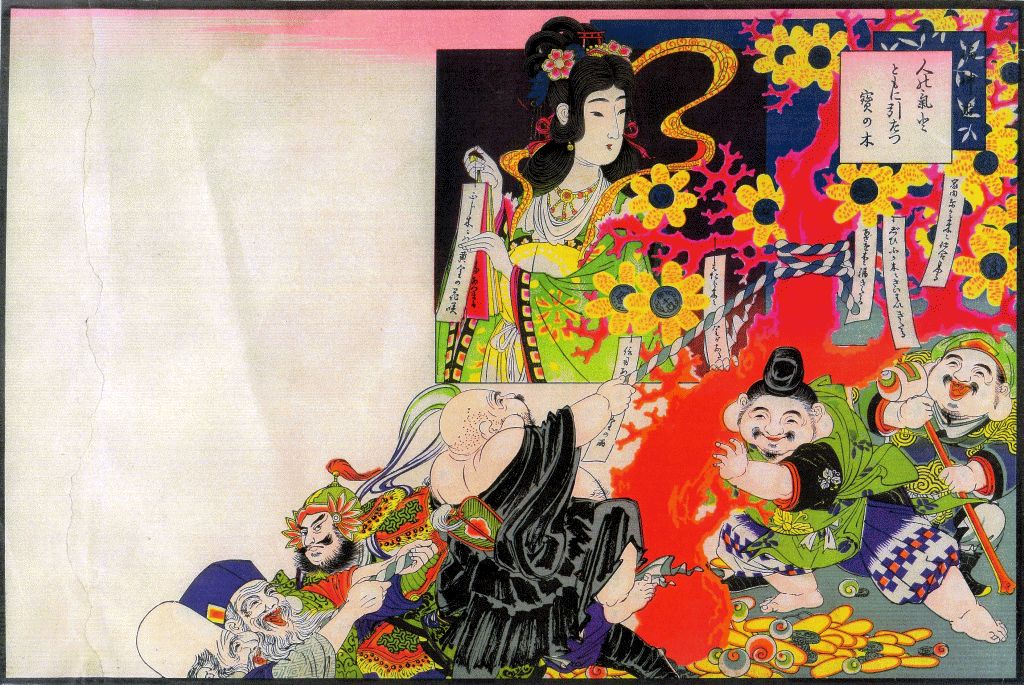
Seven Deities of Good Fortune
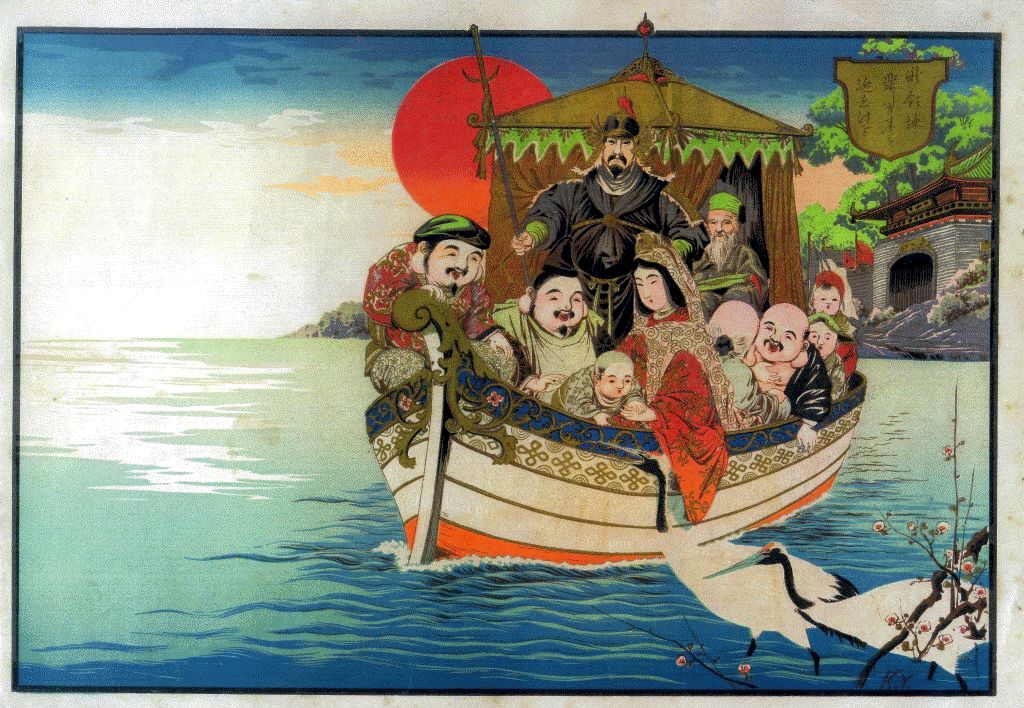
Seven Deities of Good Fortune
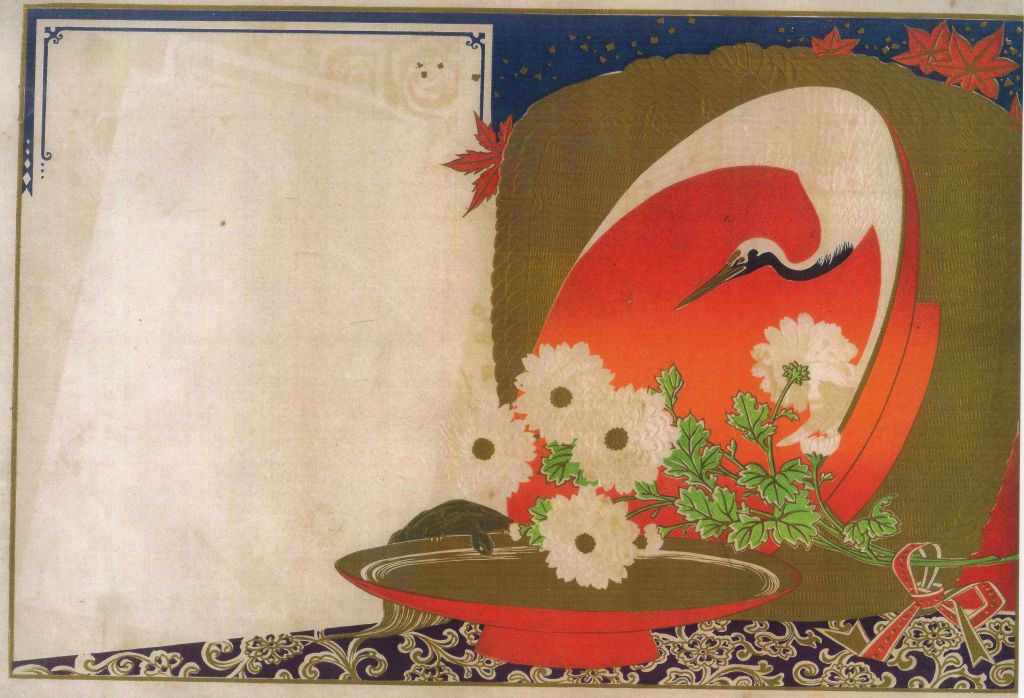
Red-crowned Crane
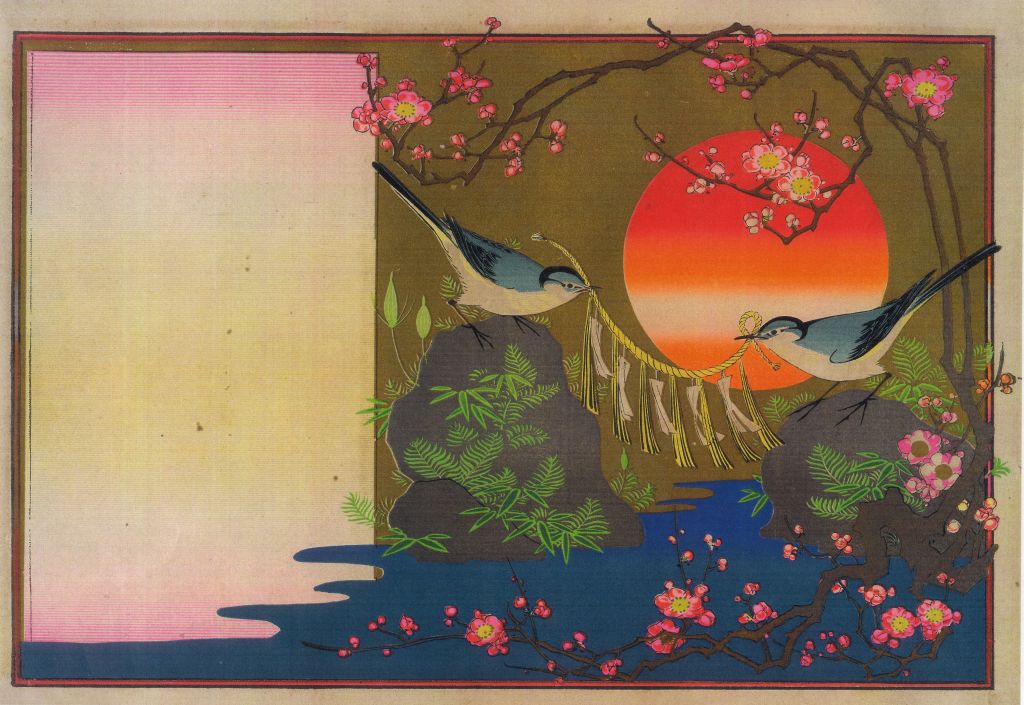
A Pair of Birds celebrates the New Year

右下に「巨泉」と書いてあり、川崎巨泉の作だろうか?
川崎巨泉(1877年-1942年)は玩具絵で有名な人物で、若いころに引札の絵にも携わったこともあったようだ。
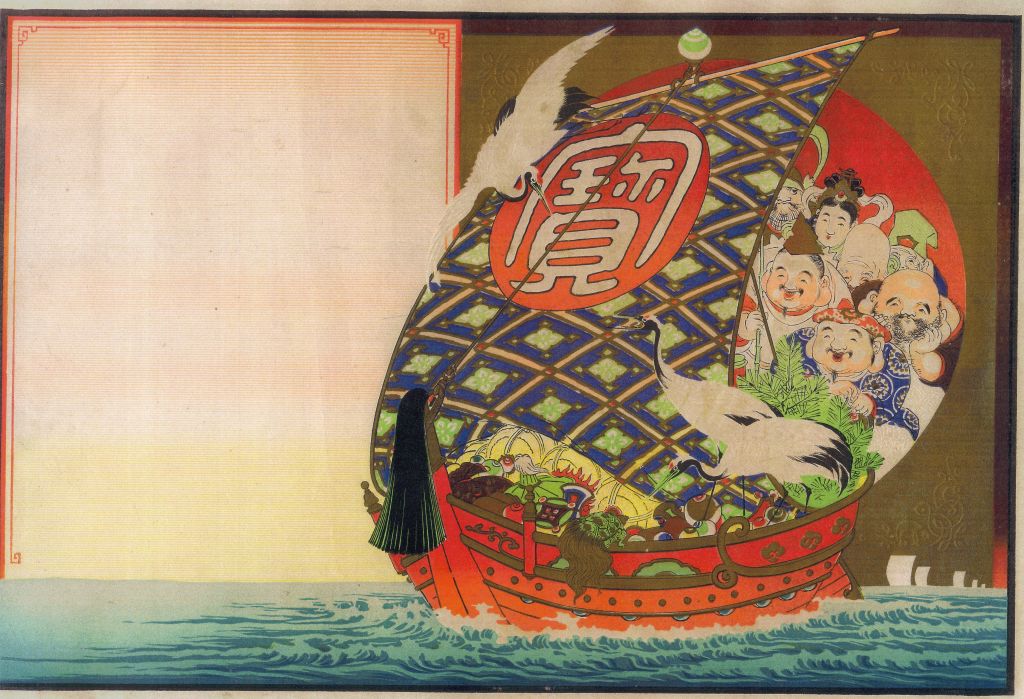
Seven Divinities of Good Luck
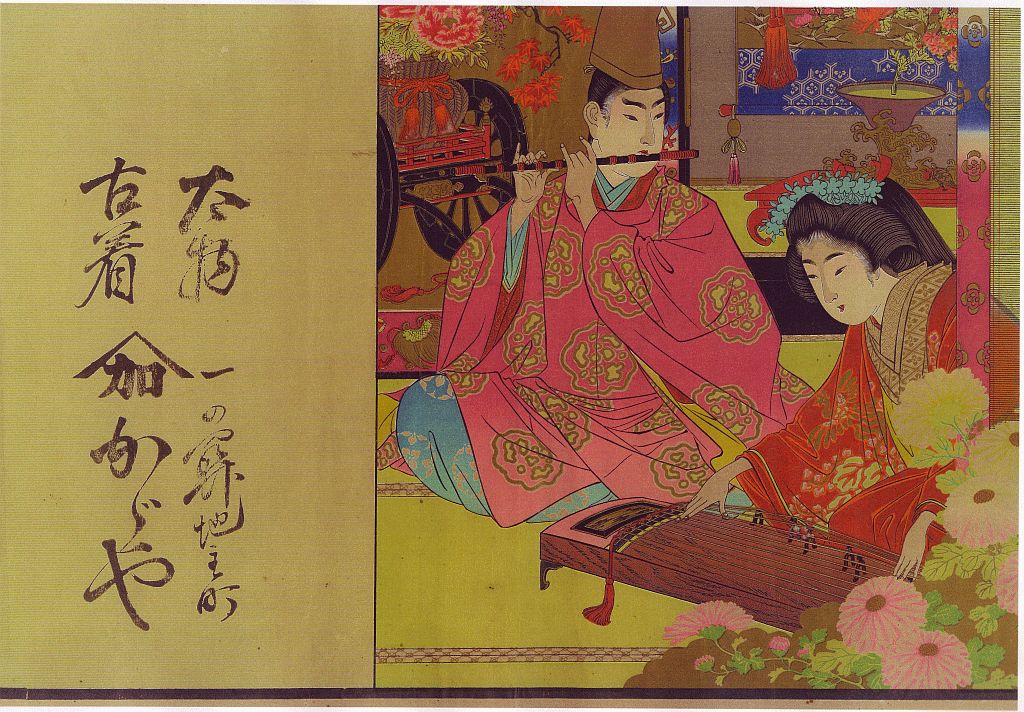
Court noble man and woman are playing music with a sort of flute and koto (Japanese harp).
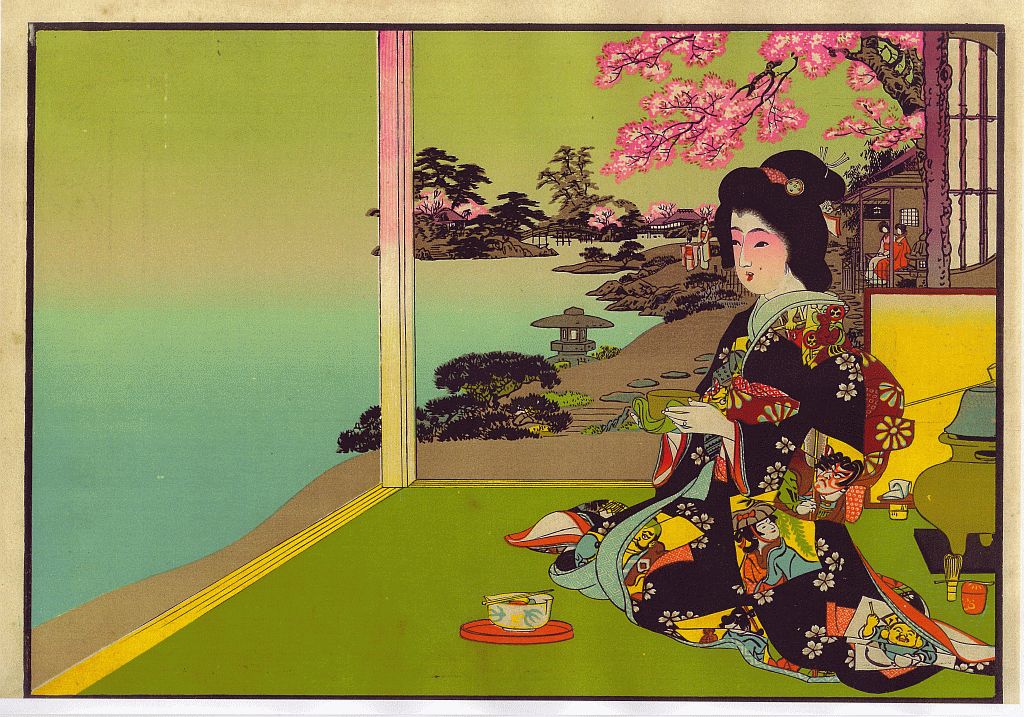
A lady in a kimono is holding a cup of matcha tea just made in a traditional tea ceremony. Cherry blossoms and a traditional Japanese garden seen in the background.
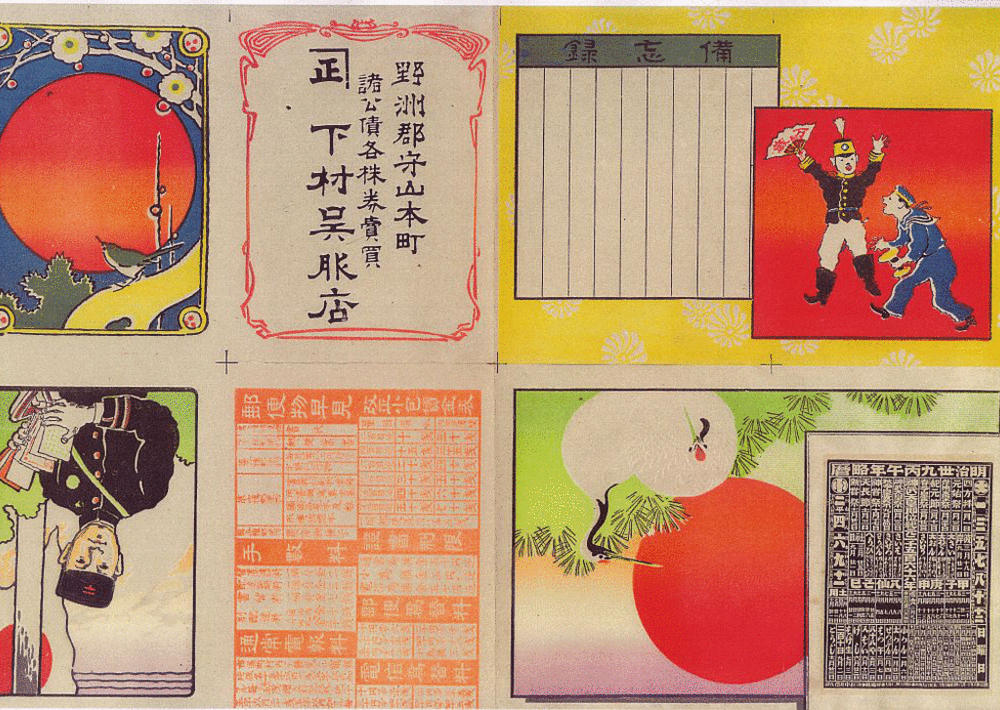
Hikifuda from Kimono shop in Moriyama city, Shiga Pref.
This is a unique Hikifuda. As you see, this can be used as memo, calendar, price chart for postage.
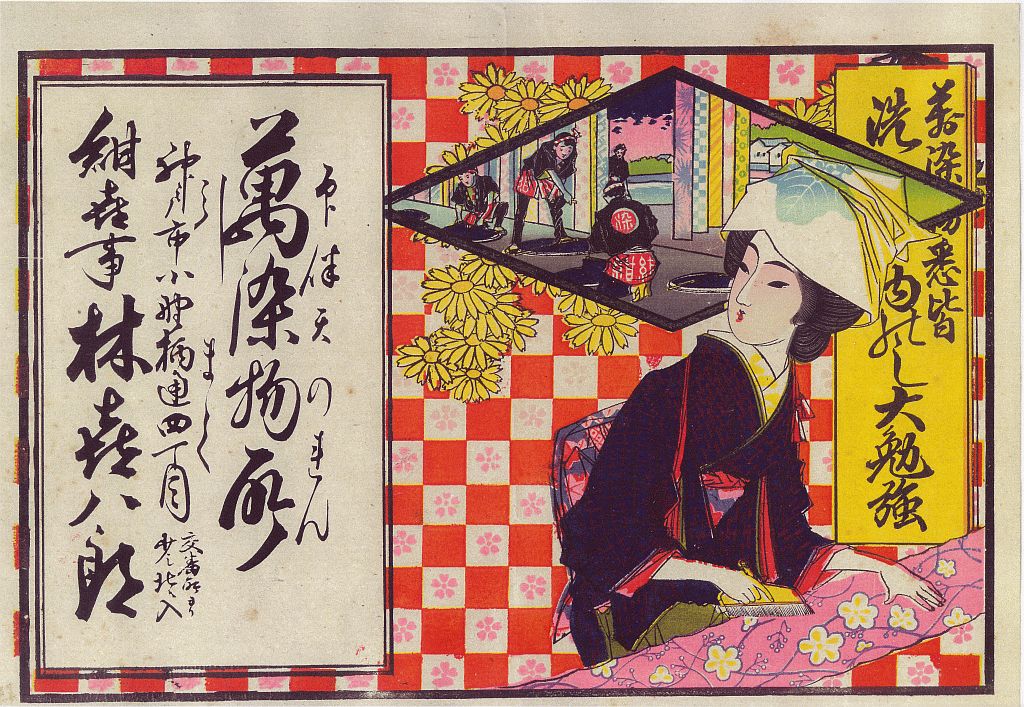
This lady is starching Kimono. On her back, men are dyeing textiles.
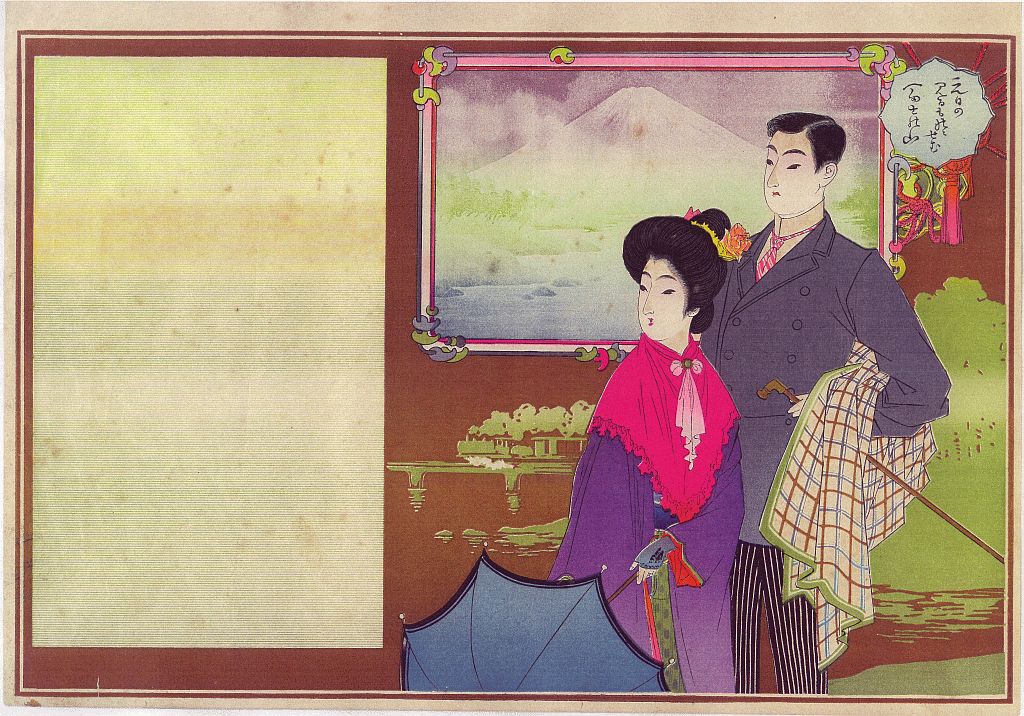
New Year Morning. Picture of Mt. Fuji is on the wall and a Haiku "Mount Fuji to watch in the morning of New Year's Day is splendid" written by Soukan Yamazaki. He is a Haiku poet in the age of provincial wars (15C-16C) and considered to be one of fathers of Haiku. Westernized costume and a railroad train symbolize "cultural enlightenment".
「元朝の見るものにせん富士の山」は山崎宗鑑(15世紀半ば~16世紀半ばの連歌師、俳人)の作という。
「元朝」ではなく「元日」と書いてあるような?
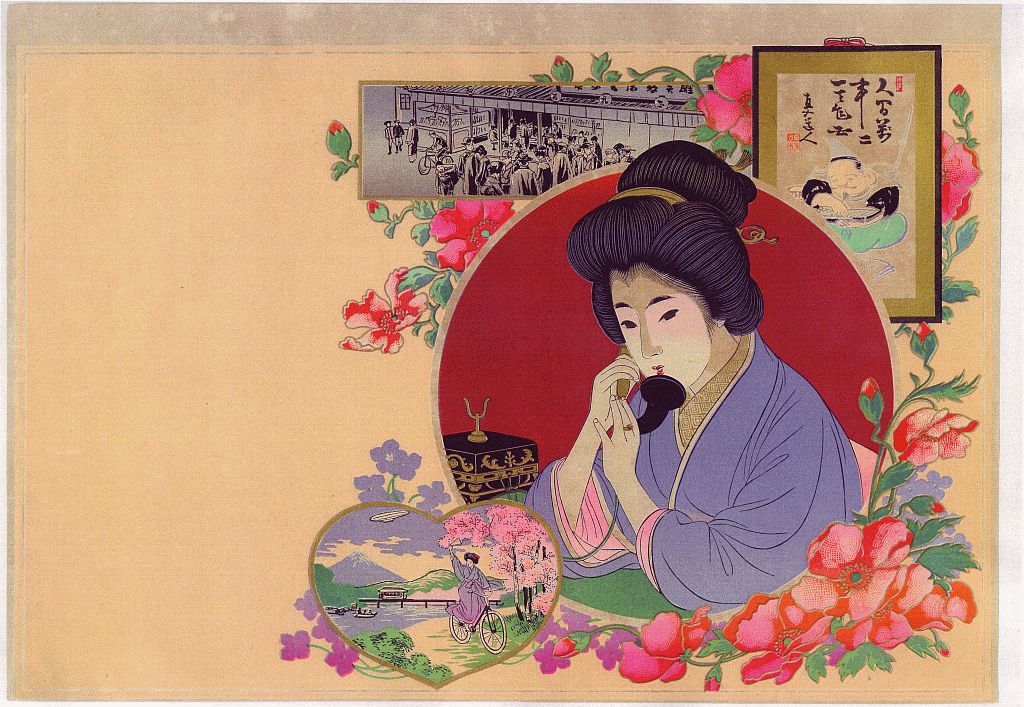
A Lady Talking on the Phone. Behind her, you can find a framed picture of Ebisu and bicycle, train and busy shop front.
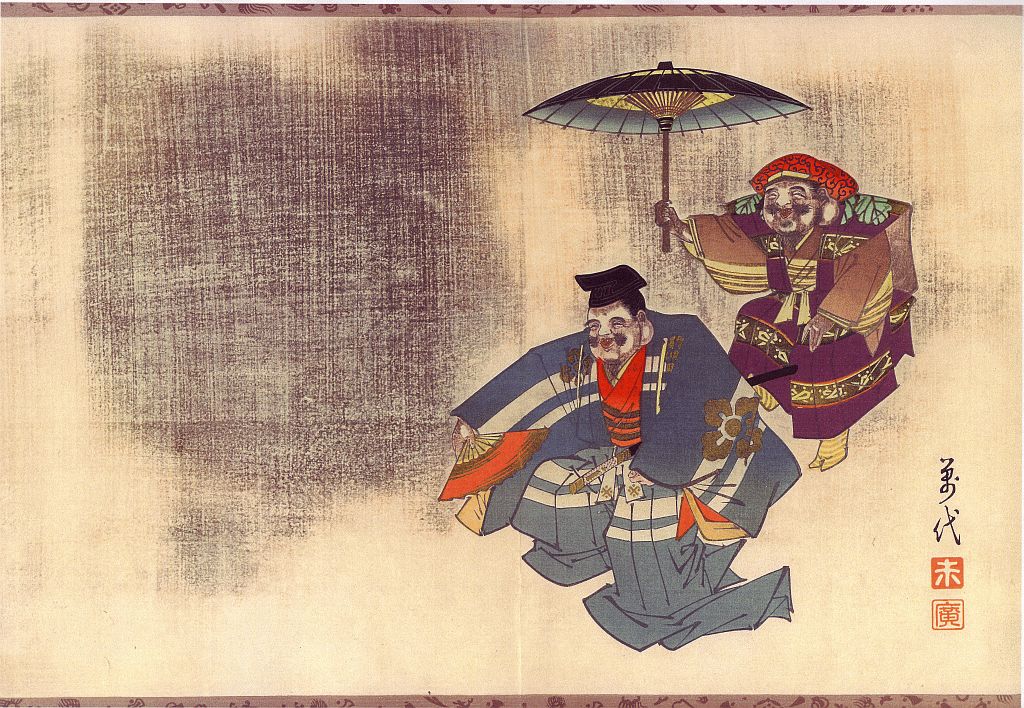
Daikoku and Ebisu : Two from Seven Divinities of Good Luck
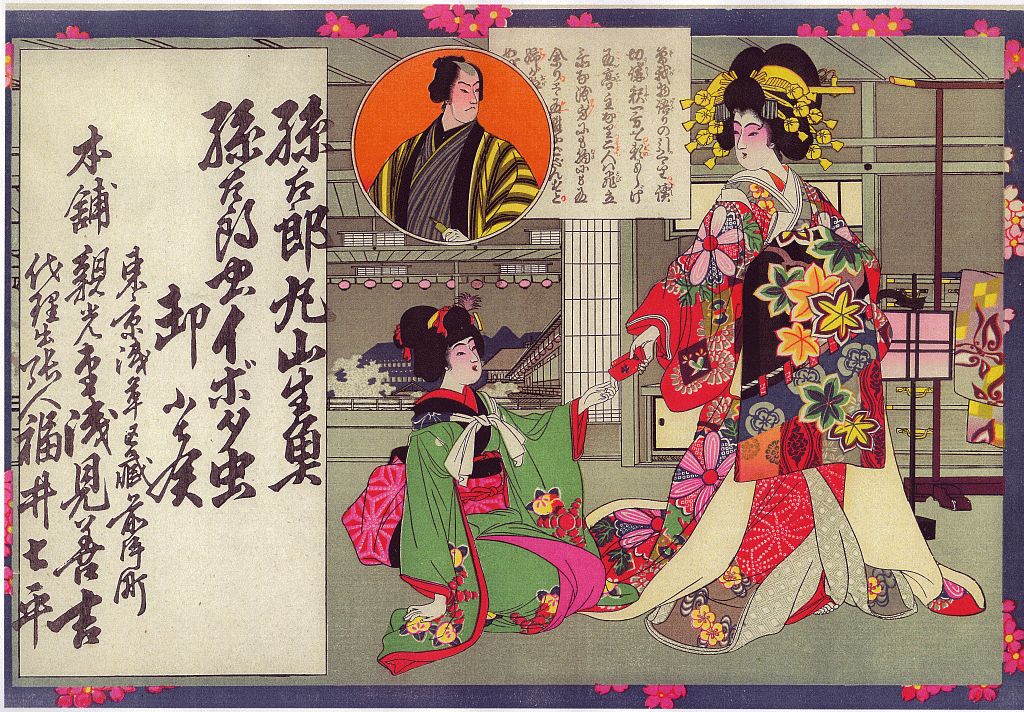
「曽我物語の引つくゝり、読み切り講釈一方を、頼もしげある亭主なり二人は飛立つ忝け涙、身にも胸にもあり余り」。江戸にいる姉を頼って奥州から出て来たおのぶは、浅草で悪人に売り飛ばされそうになるが、吉原の揚屋・大黒屋の亭主惣六に助けられ、吉原に連れて来られる。おのぶの奥州訛りを廓の人々はからかうが、同じ奥州の出身の傾城・宮城野はかばう。生まれを聞いて2人が実の姉妹であることが分かり、思いがけない再会を喜び合う。妹から父が殺され、母も亡くなった事を聞いて宮城野は仇討ちを決意する。話を聞いていた惣六は、はやる気持ちの2人を曽我物語になぞらえて諭し、協力を約束する。惣六の意見に心打たれた2人は、周到な準備をした上で仇討ちをすることにする。惣六は宮城野の年季証文と吉原大門の通行手形を与え、2人は敵討ちへと出発する。これは、享保八年(1723年)に16歳と13歳の姉妹が、田辺志摩という武士を父の仇として討ったという事件を題材にしているという。三井家南家4代目当主の紀上太郎という人が書いた人形浄瑠璃の『碁太平記白石噺』は歌舞伎にも取り入れられた。写楽作の「中山富三郎の宮城野」という浮世絵もある。
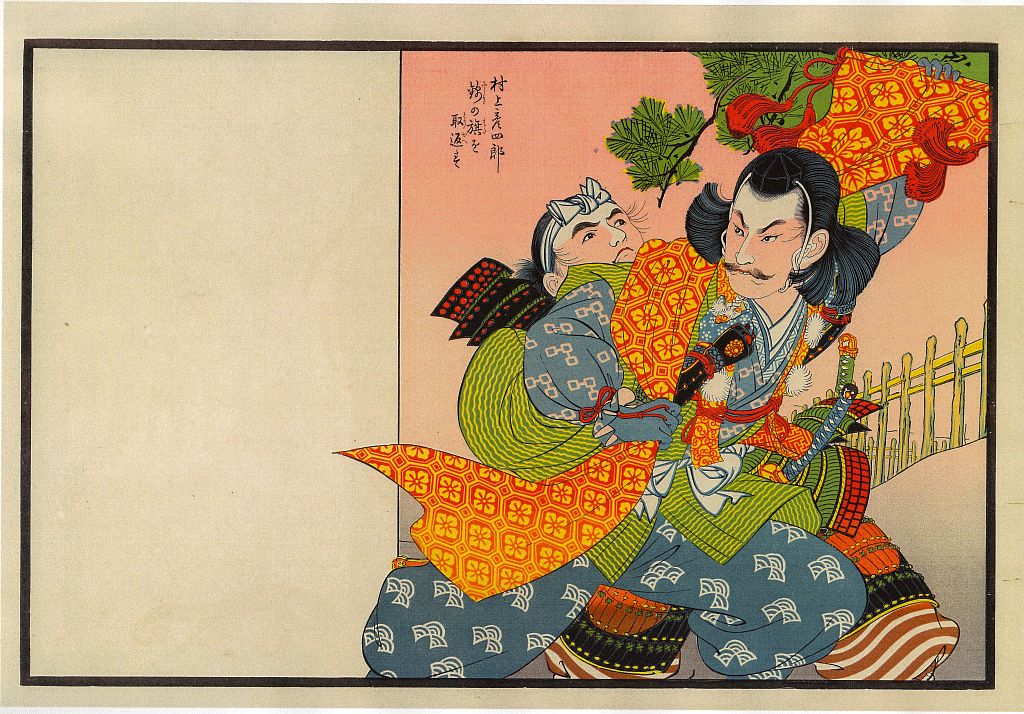
村上彦四郎(村上
義光)が、錦の御旗を奪い返すという『太平記』に出て来る話の絵。後醍醐天皇は1324年9月に鎌倉幕府倒幕を企てるが(正中の変)未遂に終わった。その後、1331年(元弘元年)に再度倒幕を企む。しかし今度も事前に発覚し、8月下旬に天皇は
笠置山に入るが、翌月鎌倉幕府軍により陥落する。幕府軍の手が伸びてきたので、天皇の子の護良親王は奈良の般若寺から9人の随臣と熊野へ向かう。この時、十津川に一時滞在するが、ここも危うくなったので高野(山)の方へ向かうことにした。「其路、小原・芋瀬・中津河と云敵陣の難所を経て通る路なれば、中々敵を打憑て見ばやと被思召、先芋瀬の庄司が許へ入せ給ひけり。芋瀬、宮をば我館へ入進らせずして、側なる御堂に置奉り、使者を以て申けるは、「三山別当定遍武命を含で、隠謀与党の輩をば、関東へ注進仕る事にて候へば、此道より無左右通し進らせん事、後の罪科陳謝するに不可有拠候、乍去宮を留進らせん事は其恐候へば、御伴の人々の中に名字さりぬべからんずる人を一両人賜て、武家へ召渡候歟、不然ば御紋の旗を給て、合戦仕て候つる支証是にて候と、武家へ可申にて候。此二つの間、何れも叶まじきとの御意にて候はゞ、無力一矢仕らんずるにて候。」と、誠に又予儀もなげにぞ申入たりける。宮は此事何れも難議也。と思召て、敢御返事も無りけるを、赤松律師則祐進み出て申けるは、「危きを見て命を致すは士卒の守る所に候。されば紀信は詐て敵に降り、魏豹は留て城を守る。是皆主の命に代りて、名を留めし者にて候はずや。兎ても角ても彼が所存解て、御所を通し可進にてだに候はゞ、則祐御大事に代て罷出候はん事は、子細有まじきにて候。」と申せば、平賀三郎是を聞て、「末坐の意見卒尓の議にて候へ共、此艱苦の中に付纏奉りたる人は、雖一人上の御為には、股肱耳目よりも難捨被思召候べし。就中芋瀬庄司が申所、げにも難被黙止候へば、其安きに就て御旗許を被下候はんに、何の煩か候べき。戦場に馬・物具を捨、太刀・刀を落して敵に被取事、さまでの恥ならず。只彼が申請る旨に任て、御旗を被下候へかし。」と申ければ、宮げにもと思召て、月日を金銀にて打て着たる錦の御旗を、芋瀬庄司にぞ被下ける。角て宮は遥に行過させ給ぬ。暫有て村上彦四郎義光、遥の迹にさがり、宮に追着進せんと急けるに、芋瀬庄司無端道にて行合ぬ。芋瀬が下人に持せたる旗を見れば、宮の御旗也。村上怪て事の様を問に、尓々の由を語る。村上、「こはそも何事ぞや。忝も四海の主にて御坐す天子の御子の、朝敵御追罰の為に、御門出ある路次に参り合て、汝等程の大凡下の奴原が、左様の事可仕様やある。」と云て、則御旗を引奪て取、剰旗持たる芋瀬が下人の大の男を掴で、四五丈許ぞ抛たりける。其怪力無比類にや怖たりけん。芋瀬庄司一言の返事もせざりければ、村上自御旗を肩に懸て、無程宮に〔奉〕追着。義光御前に跪て此様を申ければ、宮誠に嬉しげに打笑はせ給て、「則祐が忠は孟施舎が義を守り、平賀が智は陳丞相が謀を得、義光が勇は北宮黝が勢を凌げり。此三傑を以て、我盍治天下哉。」と被仰けるぞ忝き。」(
『太平記』国民文庫本・巻五)k
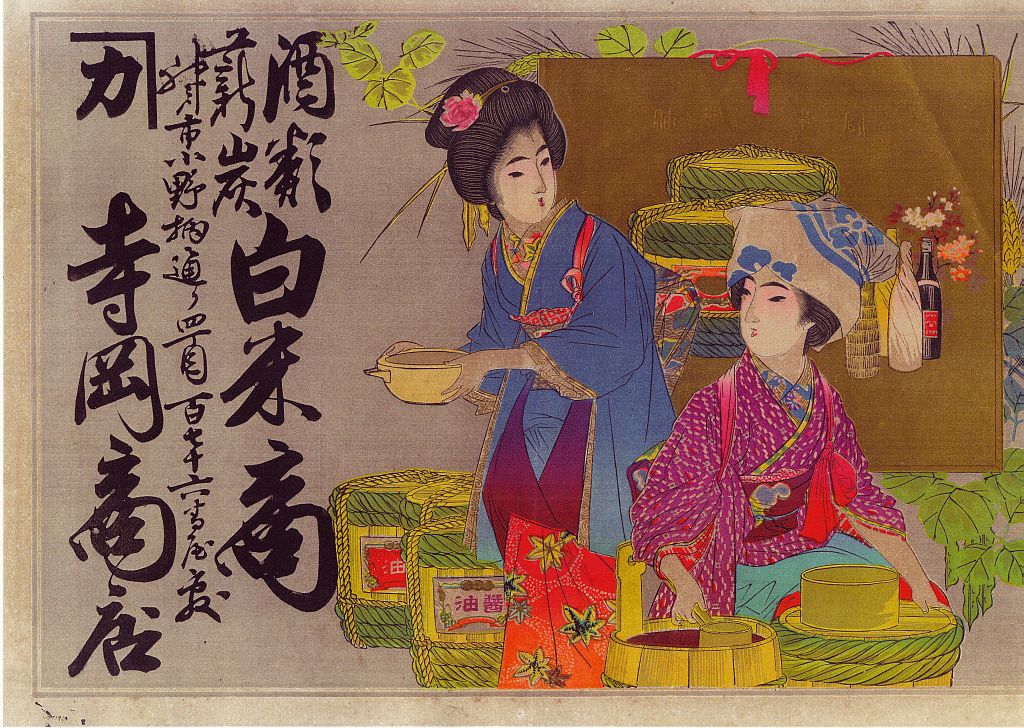
絵は醤油を売っているが、この「寺岡商店」は酒なども売っている小売店なのだろう。兵庫県神戸市中央区小野柄通四丁目は三宮駅そば、国道2号線を挟む一帯。
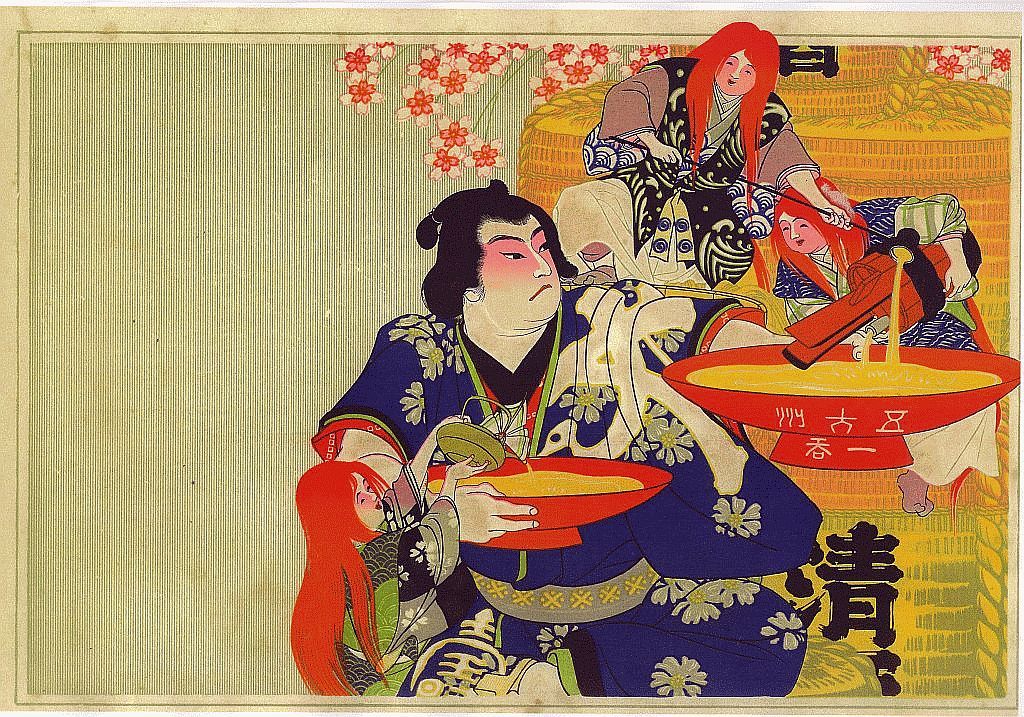
A Man holds two large cups that are being replenished by three Shojos (Sake Genies).
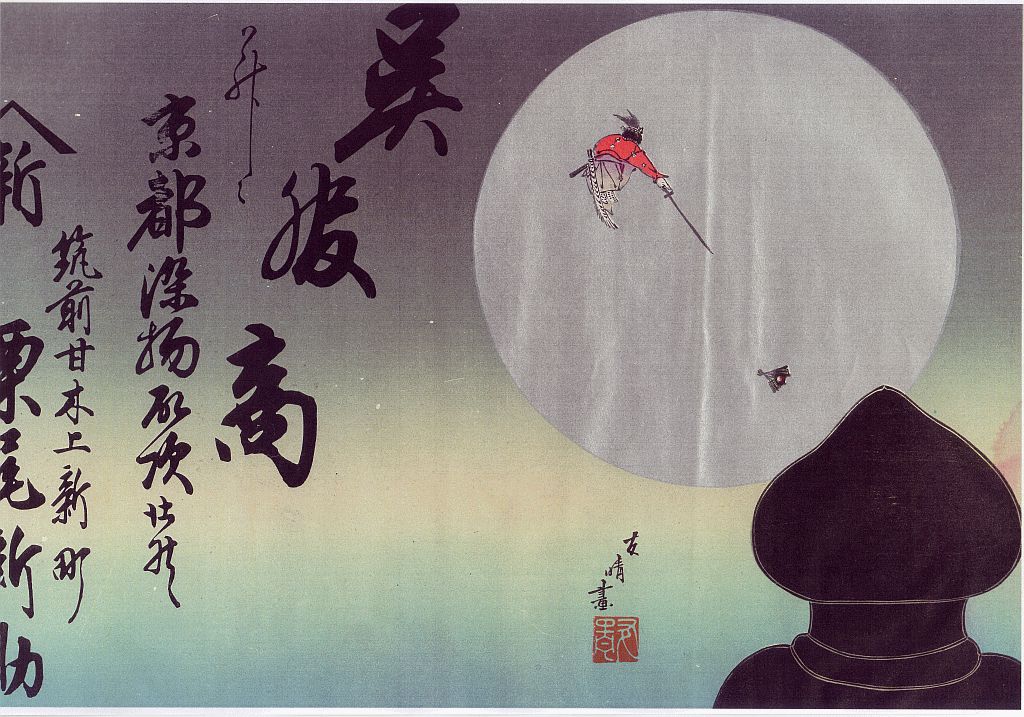
Ushiwaka-maru jumps up and throws his fan at Musashibo Benkei (Not painted here).
This is a famous scene that Ushiwaka-maru (Childhood name of Minamoto no Yoshitsune) met Benkei on the Gojo Bridge (A big parapet is painted) in Kyoto.
You can find more information about this story on Wikipedia (https://en.wikipedia.org/wiki/Minamoto_no_Yoshitsune, https://en.wikipedia.org/wiki/Benkei).

When Minamoto no Yoshiie saw a flock of geese broke up, he reminded a passage in the Tactics of Sonshi and noticed ambush.

Creating a tanka poetry out of plum-blossom and the moon.
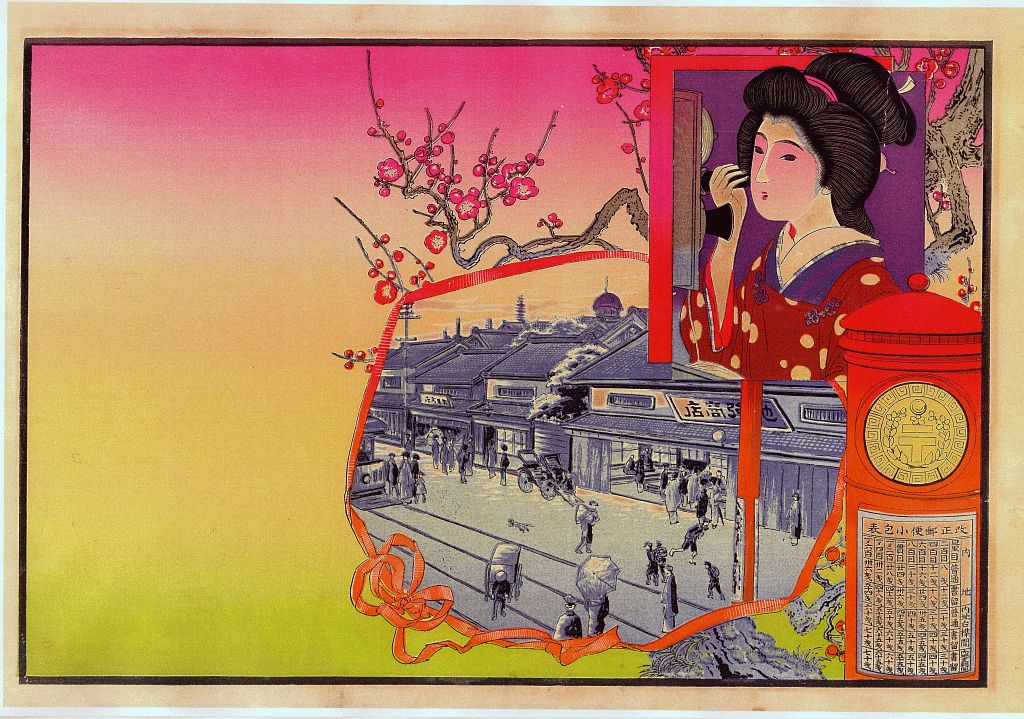
Postbox, Streetcar, Rikisha and Telephone. These are products of the cultural enlightenment.
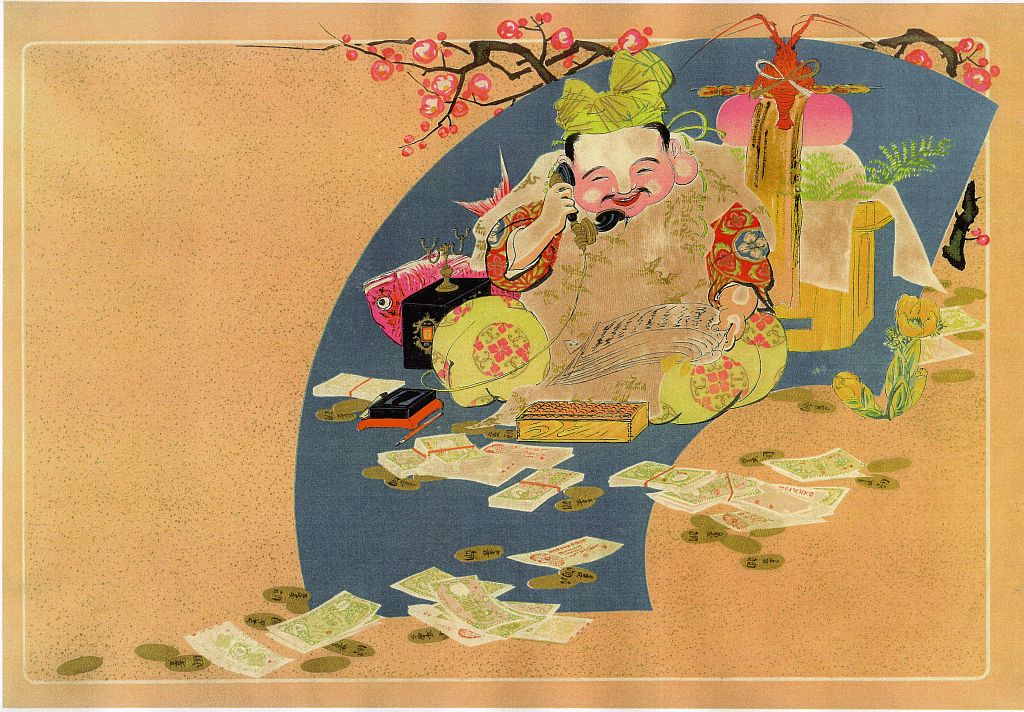
Daikokuten(Mahaa-kaala) is discussing business on the telephone.
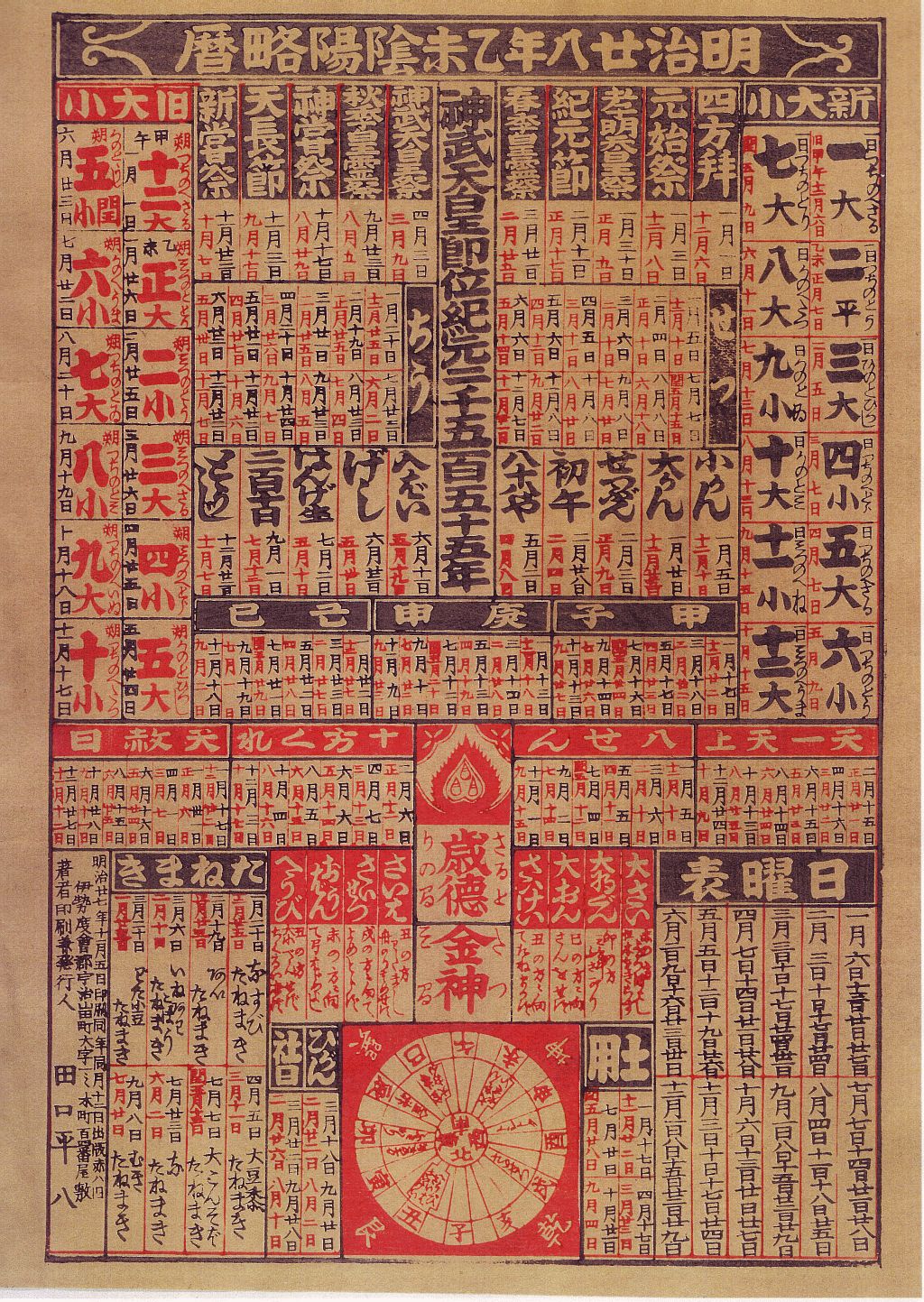
Right side is the solar calendar of Year 1895 and left side is the lunar calendar. Japan adopted Gregorian calendar in 1873. But many people still preferred lunar calendar because of not just custom but it fitted their annual events.
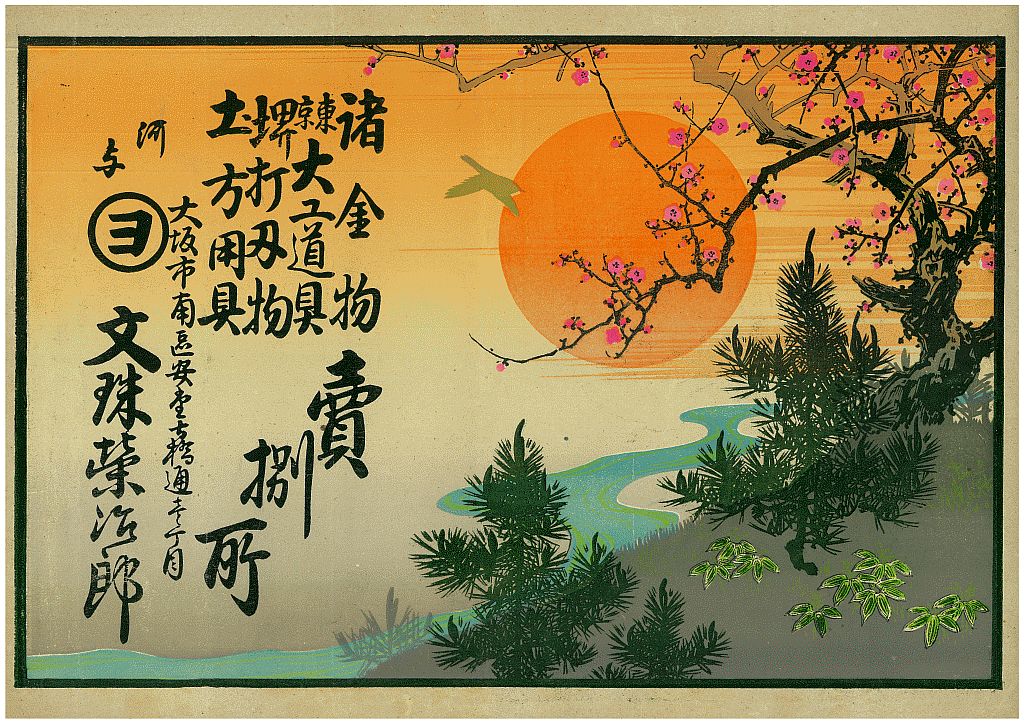
Hardware store in Osaka.
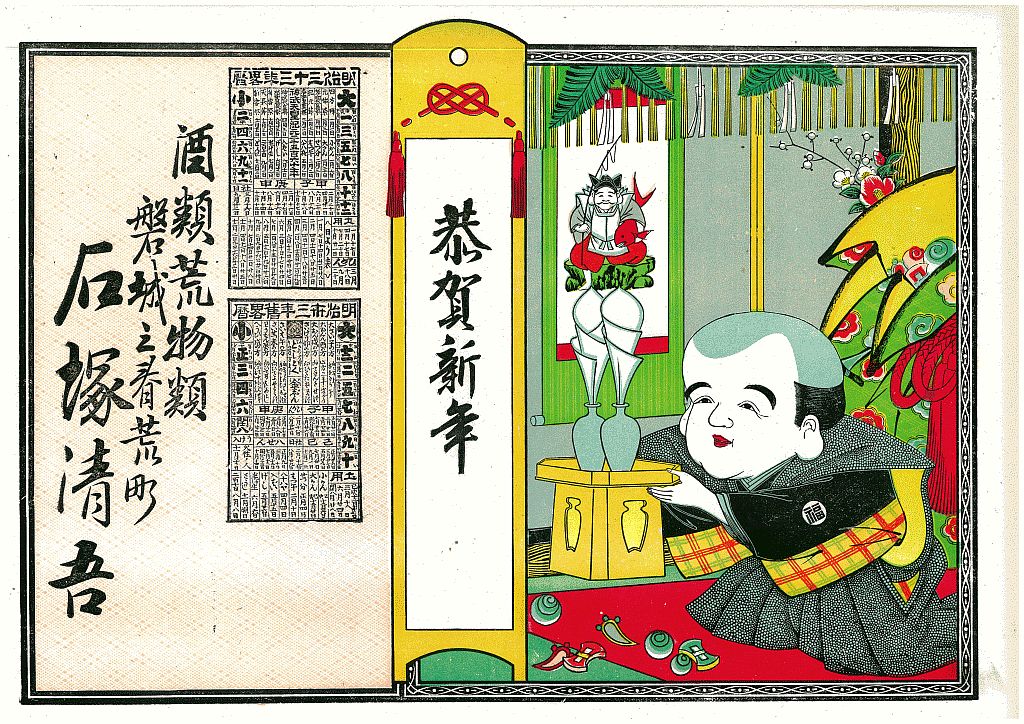
Fukusuke cerebrates a New Year. Solar and Lunar Calendar of 1900 are on the left side.
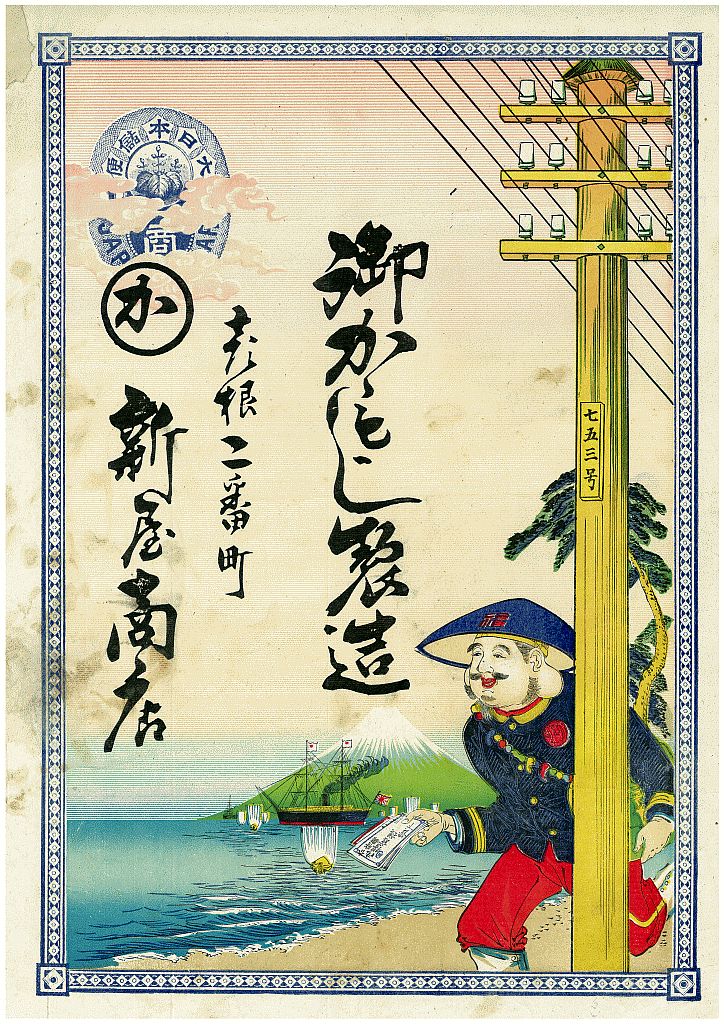
Kamoji manufacturer's Hikifuda. Mt. Fuji, a Steamboat and Telegram delivery man. He is Daikokuten (Mahākāla). In Japan, this deity is variously considered to be the god of wealth or of the household
(https://en.wikipedia.org/wiki/Mahakala#Mahakala_in_Japan). Kamoji means "Hairpiece".


























